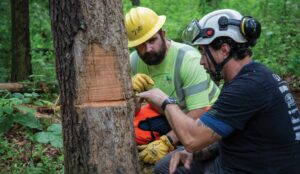by Andrea Hahn

Beginning this fall, agriculture students at Southern Illinois University Carbondale have the opportunity to learn about the next game-changing agricultural tool before it takes off – literally. Unmanned aerial vehicles (UAVs) — or drones as they are popularly known — are in hover mode and poised to change farming. Christopher Clemons and Dennis Watson, faculty members in the College of Agricultural Sciences, have prepared a course of study to help SIU students become leaders in the newest agricultural technology.
Students will be introduced to unmanned aerial vehicles and applications, including learning about UAV types for agricultural use; maintenance and repair; remote sensing attachments and use of lens filters for UAV scouting; and operating and application of the data gathered for agricultural use.
“The most obvious application is for precision agriculture,” Clemons said. “But UAV technology has applications for all our majors.”
Precision agriculture uses global positioning system (GPS) and other data to allow farmers to manage smaller units within their fields, enabling them to customize fertilizer, water and disease-control for the areas of the field that need it. Right now, most unmanned aerial vehicles intended for agricultural use are data-gatherers. Equipped with a high definition camera and the specific lenses and filters, UAVs gather information on stress-level in plants, calculate areas of weather or disease damage and help farmers predict yield.
Other applications for agriculture include assisting livestock producers by assessing forage health for grazing rotation, or measuring canopy health or tree density for foresters.
Some farmers might invest in UAVs of their own, while others might hire out to precision agriculture consulting companies, several of which are already taking off. The Association for Unmanned Vehicle Systems International, the trade group representing UAV manufacturers and users, predict that 80 percent of the commercial UAV market will eventually be agriculture. Similar predictions forecast more than 100,000 jobs in the UAV market by 2025 and an economic impact in the hundreds of millions of dollars.
“We are at the brink of the next technological revolution for agriculture,” Clemons said. “This is similar to the time when farmers first began using GPS technologies to improve farming techniques and efficiency. We want our students to be ready for this. It’s going to be the fastest-growing area for agricultural professionals.”
At present, unmanned aerial vehicles and unmanned aerial systems (the drone and its controls) occupy an uncertain position within Federal Aviation Administration rules. Section 333 of the FAA Modernization and Reform Act of 2012 permits the Secretary of Transportation to authorize, on a case-by-case basis, operations for unmanned aerial systems for commercial use. So far, the FAA has granted 822 petitions.
“We’re developing students and future agricultural professionals who make decisions based on data,” Clemons said. “We’re still teaching what we call ‘ground truthing’ because there isn’t a substitute for that. But these UAVs will change the scope of agriculture for all of our students. The aerial data is going to be an extension of the GPS data that is already available in planters and combines and tractors.”
Watson said industry partners are crucial to keeping the hottest, newest agricultural technology in students’ hands. In turn, he said, the university will turn out students who are immediately ready to step into leadership positions.
“We’re not going to wait, we’re going to begin preparing our students now,” he said. “The technology is here and it is advancing, and we want our students in the front of it.”









